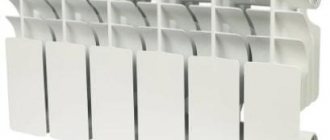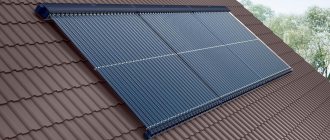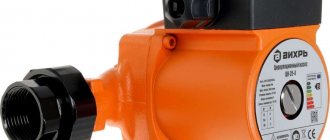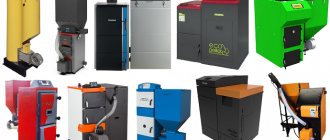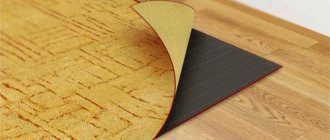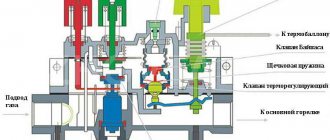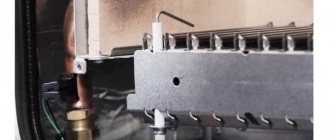For a comfortable atmosphere in a room, a central heating system is not always enough. In this case, as an alternative option, manufacturers offer convectors with electronic and mechanical control. Thanks to the design of the device, the user can optimize the process of heating the room. The built-in mechanical thermostat allows you to regulate the temperature with a deviation of 10C. Due to their affordable price, efficiency, and small amount of space, heating devices are popular among consumers.
What types of thermostats are there for autonomous heaters?
It is customary to distinguish two main types of thermostats:
- mechanical devices;
- electronic (programmable) devices.
Mechanical thermostats are characterized by their simple design. They are not connected to a stationary power supply; the temperature level is controlled by a special membrane that is sensitive to heating and cooling. When a certain temperature is reached, the membrane disconnects the network and the heater turns off. The sensitivity of such a device is half a degree, the temperature range is from +50 C to +302 C. Mechanical thermostats are mounted on the wall. Mortise or overhead installation allows them to be used with any type of wiring.
Electronic thermostats are equipped with a display that displays processes in the heating system. They can be equipped with two sensors that monitor the temperature of the air and heated floors. Electronic devices are more precise than mechanical devices, the adjustment range is from +50 C to +450 C. More expensive programmed models can be built into the Smart Home system and allow you to regulate the air temperature over a certain period of time. Thermostats are universal devices; if necessary, they can serve electric heated floors.
Features of connecting thermostats to heaters
The heater is installed like all electrical appliances; it is powered through an outlet or a separate line. The thermostat is mounted between the electrical panel and the heating device. The thermostat has 4 contacts, two for input and two for output. The machine from the electrical panel is connected to the input terminals, and the heating equipment is connected to the output terminals in accordance with the polarity. According to this principle, one thermostat is installed for one heating device. In the case when it is necessary to connect a pair of heaters in series, a pair of wires goes from the thermostat to one, and then to the other heating device. With the parallel type of connection, 4 wires are removed from the regulator per phase and neutral and directed to the heaters. Electrical cables are not included with the thermostats and must be purchased separately. For correct operation of the devices, thermostats should not be mounted in drafts, in direct sunlight, or on the outside of the wall.
Nobo thermostat control
The Norwegian company Nobo is deservedly considered one of the best European manufacturers of electric convectors. The company's specialists have developed two compatible remote control systems for convectors and other electrical appliances. The Orion 700 system allows you to set 4 convector operating modes on your control unit:
- turned off;
- antifreeze (+8°C);
- economical;
- comfortable.
Together with the Orion 700 control system, the R80 RDC-700 thermostat is used, on which the temperatures of the economical and comfortable operating modes are set manually.
In addition to convectors, Orion 700 can control heated floors (via the TRB 36 700 thermostat), other electrical appliances (via the RCE 700 socket receiver, the RS 700 receiver included in the power supply circuit or the RSX 700 receiver installed in the electrical distribution panel/cabinet).
In total, the system can control up to 100 zones. Connecting the Orion 700 control unit to the GSM module allows you to control the system remotely, transmitting certain control commands via SMS messages. The Energy Control system is compatible with the Orion 700 and can control all of its receivers, but has greater capabilities using the Internet. It can also control thermostats R80 RXC 700 (with the ability to regulate temperature and operating modes in the program itself installed on a smartphone or tablet), R80 RSC 700 (with the ability to regulate temperature and operating modes in the program itself installed on a smartphone or tablet or manually mode with setting the temperature on the thermostat itself) and TCU 700 (glass convector Safir II).
Nobo Energy Control Control Diagram
Control is carried out from the Ecohub wireless controller, which can connect to the Ecoswitch wireless mode switch or work through a Wi-Fi router. Using a router connected to the Internet allows you to control convectors, heated floors and other electrical appliances from a remote terminal (smartphone, tablet).
For ease of use, electronic convectors can be controlled via Wi-Fi and GSM channel.
Thermostat connection diagrams
Depending on the characteristics of the equipment used, several connection options are offered. Among them:
- with connection without control wire;
- with control wire;
- using “carrier current”, connecting with or without a control wire.
Let's consider each option separately.
Connecting a thermostat without a control wire
This scheme has two options:
- when connecting convectors with a power of less than 1100 Watts;
- with convectors with a power of more than 1100 Watt.
In the first case, there is no need to install a power switch. The connection diagram will look like this:
How is a thermostat different from a thermostat?
The meaning of the word " thermostat"
"may imply a separate element, while a "
thermostat
" is a completely independent device, which includes a heat regulator.
Interesting materials:
What do you need to send a letter? What do you need for a trip to Issyk Kul? What do you need to travel to India from Ukraine? What do you need to travel to India? What do you need to get a free parking space for families with many children? What is needed to receive the parcel? What is needed to obtain rights? What do you need to get an installment plan in Eldorado? What do you need to get an installment plan? What is needed to obtain a certificate for the traffic police?
Manufacturers and popular models: ranking of the best and prices
The rating of the best models, mechanical and electronic, will help you not make a mistake in choosing a thermostat. A user who is familiar with the features of their operation will be able to buy the most convenient thermostat for their heater.
thermostat Ballu BMT-1
A mechanical thermostat designed specifically to work in conjunction with IR heaters of this brand. The range of adjustable temperatures is from +10°C to +30°C. Compatible with single-phase heaters up to 2 kW. The thermostat housing is made of impact-resistant white plastic. On the front panel there is an LED indicator of the device operation.
Characteristics:
- dimensions - 83x83x38 mm;
- weight - 165 g.
Cost 615 rub.
Mechanical temperature controller Neoclima RQ-1
Surface-mounted mechanical thermostat with white plastic housing. Recommended for connection to PPI and thermal curtains. The range of adjustable temperatures is from +5°C to +30°C. Widely used for temperature control in heating and air conditioning systems. Has a high degree of moisture and electrical protection. Weight - 100 g.
Mechanical thermostat and its operating principle
User's Manual
The thermostat used for heating system radiators includes a valve and a high-sensitivity element called the device head.
The device operates autonomously without the need for external influence.
The main element (thermal head) includes a liquid element and a drive.
Remember: In order to purchase the optimally suitable device option, a detailed study of the system is necessary to identify all the associated nuances that need to be strictly taken into account.
Main working parts:
- thermostatic valve;
- an element of high sensitivity to changes in certain indicators;
- thermostatic element;
- detachable type connection;
- rod and spool;
- compensation mechanism;
- union type ring and nut;
- scale by which the system is adjusted.
Factors that have a direct impact on the temperature of the system:
- Ventilation of the room;
- Ultraviolet rays of natural origin;
- Ambient temperature indicators;
- Electrical cooling or heating devices located indoors.
Principle of operation:
Due to climate change in the external environment, the temperature indicators of the coolant also change, to which the spool reacts by changing its location.
The spool is a direct indicator of changes in air temperature values in the room. By means of this factor, the rod that closes the system valve is automatically moved.
As a result, the supply of hot contents into the cavity of the battery located in the room is regulated.
Reviews of popular models with a power of 2 kW
The modern market offers a huge number of convectors with a mechanical thermostat. The best models are presented with all the necessary functionality: double insulation of live parts, overheating protection, power selection and electricity saving. Let's look at some models.
ENSTO EPHBM20P
The electric convector with a mechanical thermostat 2000 W has dimensions of 152.3 x 38.9 x 8.5 cm. The temperature can be adjusted using a mechanical thermostat. The installation of the device is universal: both floor and wall. Weight approximately 8.6 kg. The device has additional options: frost protection, overheat shutdown. The disadvantages include uneven heat distribution over the housing area.
Convector ENSTO EPHBM20P
Noirot CNX-2 2000
The convector with a mechanical thermostat is of high quality. The French company Noirot is the largest manufacturer of heating equipment. The heating area of the device is 25 square meters with a power of 2 kW. The body is made of a protective coating. Dimensions 74 x 44 x 8 cm. Model CNX-2 2000 – compact, silent, with reliable wheels. The disadvantages of the model include low-quality legs, which break off during use, and a short cord. The product is premium class.
Convector Noirot CNX-2 2000
Electrolux ECH/AG2-2000 MF
The convector is made of a moisture-proof housing and has dimensions of 80 x 41.3 x 11.2 cm. The weight is small - 5.15 kg. Can be wall mounted and comes with additional wheels. Using a mechanical thermostat, you can set two power levels: 1000/2000 W.
Convector Electrolux ECH/AG2-2000 MF
Ballu RED Evolution BIHP/R-2000 White
An inexpensive mechanically controlled convector made in Russia has an original design. Product dimensions 80 x 41.3 x 11.1 cm. This model is distinguished by a switch with an indicator light. The front surface is made of metal mesh. Weight is 5.4 kg. The advantages include the versatility of the model: the device can be installed on the wall and as a free-standing device.
Convector Ballu RED Evolution BIHP/R-2000 White
Electric convectors with mechanical control are the best option for those who value safety, convenience and reliability. The beautiful design of heating equipment combined with high efficiency makes climate control equipment indispensable in a residential area.
Convector device with mechanical thermostat
The design of electric convectors has been modernized throughout the development of heating technology. Today, their production technology has been improved, and devices with mechanical control are cheaper than their electronic counterparts. This is due to the fact that the development of convectors requires less cost and occurs faster.
An electric convector with mechanical control consists of the following elements:
- frame;
- thermostat;
- heating element (heating element);
- air vents with guide louvers;
- fuse protecting against overheating;
- switch off/on buttons;
- multi-position switch for supplying voltage;
- built-in sensor against accidental tilt (additional option).
Important! The devices are intended for dry, ventilated rooms. If the room has high humidity, the housing material should be made of moisture-proof materials and be marked IP24.
Using programmers: ease of control of heating devices and efficiency
Programmers, which are a separate type of thermostat, are used to control the heating system in the house, including remotely via the Internet or via SMS notification. But the possibility of remote access to the heating system as a whole and its individual elements is a kind of bonus that adds convenience to operation.
Using a programmer, unlike other types of temperature control devices, can significantly reduce energy consumption by optimizing its consumption while maintaining conditions to ensure the desired level of thermal comfort in the house. To do this, depending on the needs of the family, you can choose a weekly or daily programmer. The first allows programming according to the 5+2 or 5+1+1 scheme, which is most convenient for those families for whom staying in a country house is limited to two days off. But in addition there is the possibility of separate interval settings for weekdays and weekends.
Daily programmers are installed in cases where a family lives in the house permanently and their algorithm allows you to set the temperature control in the house in three modes:
- comfortable overnight;
- comfortable daytime;
- economical.
The first mode is used at night and its main characteristic is that the thermostat is set several degrees lower than during the day, which is more comfortable for sleep and allows you to save energy.
Daytime comfort mode is most in demand at a time when all family members are in the house, that is, in the morning and evening. When all residents are outside the house, it is possible to set an economical mode, in which the temperature is maintained at a minimum level.
An important advantage of using programmers is that these devices are as informative as possible: all the necessary information is displayed on the LCD screen:
- date of;
- air temperature;
- operating mode of the system or its element (if a local device is installed);
- boiler operating mode;
- on/off time;
- Battery charge level (for standalone programmers).
In some models of programmer, information about the operating status of the devices can be displayed on the display screen, including error codes indicating a problem.
Depending on the type of connection, programmers can be wired or wireless, consisting of two functional elements, the exchange of information between which occurs remotely, via a radio channel.
How the convector is controlled
To understand how a convector works, you need to understand how to control the device.
Mechanical or electronic thermostats are built into convectors:
- Inexpensive models have built-in mechanical thermostats. When they reach a certain temperature, they open the electrical circuit. After the device cools down, the circuit closes again and the convector heats up again. The air space temperature is not taken into account here; the thermostat is activated by heating the bimetallic plate. This is considered a disadvantage of this type of management.
- If the convector uses an electronic type of control, then there is interaction between several sensors. They monitor the degree of heating of the convector itself and the temperature in the room. The microprocessor processes the data received into it and thus corrects the operation of the convector. Another advantage is that there is a panel on the case with which you can set the desired temperature. Sometimes heaters come with remote controls, which is even more convenient. The most expensive models are equipped with modules in which you can program the temperature in an apartment or house for several days in advance. For example, when no one is home during working hours, the temperature can be significantly reduced. By the time the owners arrive, the convector will have time to warm up the room again. The device body has slots for air intake.
Installation Tips
Some tips:
- Before purchasing a TR, you need to make sure that the characteristics of the regulator and heating elements are compatible.
- You need to choose to install the device in the most accessible location.
- When deciding whether to purchase a device, you should evaluate the economic feasibility of using a specific thermostat model.
- If you do not have enough experience in installing such devices, then it is better to seek help from specialists.
A person sometimes has no idea about the number of thermoregulatory devices around him. They became a part of everyday life. Their work brings significant savings in energy costs.
Caring for the surface of the device
An electric convector is a heating device that, with the help of simple recommendations, will last for decades. To ensure the device functions for a long time, follow these tips:
- Periodically wipe dust accumulation areas with a damp cloth (air openings, top panel, thermostat);
- Wipe the device regularly with soapy water and then wipe dry;
- do not obscure the grilles with furniture, curtains or other things;
- in the summer, wrap the device in a plastic bag - this will protect the electric convector from insects and dust.
Note! The device works if circulation occurs unhindered in the air duct openings. To avoid device failure, do not cover the electric convector.
Advantages and disadvantages of the device
This type of convectors has its advantages:
- low surface temperature;
- ability to withstand temperature changes;
- ease of operation and maintenance;
- low-temperature heating elements do not burn oxygen and do not emit foreign odors;
- high level of efficiency - more than 90%;
- low noise level;
- safety;
- easy installation of the device;
- inexpensive price compared to electronic control of the device;
- long service life.
A mechanically controlled electric heater also has its disadvantages:
- clicks when the thermostat operates;
- inaccuracy of the set temperature: within 10C.
Main varieties
Based on the principle of location, mechanically controlled convectors are divided into:
- wall;
- mounted;
- floor;
- universal.
The air is heated in devices in different ways, therefore, based on the heating method, heating equipment with a mechanical thermostat is divided into the following types: gas, water and electric convector.
Convectors in questions and answers
Most manufacturers produce special series of convectors for rooms with high humidity. The housing of such devices has splash protection in all directions and additional electrical protection. For installation in the bathroom they do not require additional grounding. Some convectors can serve as a heater and heated towel rail in the bathroom.
However, when installing an electric heater, you must follow some rules. The distance from the bathroom to the appliance must be at least 0.6 m, the control panel and cord must be on the other side. This precaution is necessary to avoid accidentally grabbing the wire with wet hands and getting an electric shock.
What type of thermostat is better to buy a convector?
The convector can be controlled using an electronic or mechanical thermostat. Experts recommend purchasing a convector with an electronic thermostat. This is explained by some of its advantages over mechanical ones.
Using an electronic thermostat, you can regulate the temperature with an accuracy of 0.1°C, while with a mechanical thermostat only from 1°C. Over time, a mechanical thermostat “wears out” and gives an accuracy of about 3°C. Electronic ones last much longer. At first glance, such a change in temperature seems imperceptible, but it affects the feeling of comfort in the room and the well-being of a person in general.
The mechanical thermostat makes a clicking sound when turned on and off. If the convector is installed in the bedroom, this may interfere with a restful sleep. The operation of the electronic thermostat is absolutely silent.
A mechanical thermostat is very sensitive to power failures. With frequent voltage fluctuations, it quickly fails. An electronic thermostat is more reliable and is not affected by power surges.
The price of a convector with an electronic thermostat is slightly higher than with a mechanical one, but it will help you save electricity consumption by automatically adjusting the power.
Is it safe to install a convector in a children's room?
Absolutely all electric convectors are safe for installation in children's rooms. During their work, they do not burn oxygen and dust, which settles on the device body. It is almost impossible to get burned from touching the device. Even in full power mode, its body does not heat above 80°C. With their help, you can create a comfortable and soft thermal regime.
In addition, manufacturers of electric convectors produce highly specialized models designed for installation in children's rooms. The body of such a device heats up to only 50°C, and the exhaust air warms up only to 60°C. The design has no sharp corners that could injure a child. The fastening elements have special chains that prevent the device from accidentally falling. The heating elements are protected by a grille from the ingress of foreign objects and their ignition.
A child will not be able to reprogram the operating mode of such a convector, since its control unit is protected by a special casing. The auto-restart function restores the convector to the set mode after a power failure. Additional protection against overheating is also provided. If a child accidentally closes the upper blinds of the device, it will stop working.
Why is it better to install an electric convector for heating rather than an oil heater?
First of all, an electric convector will save money on paying electricity bills. Its consumption is 20–25% less than that of an oil heater. The reason for this lies in their operating principle. In an oil heater, the heating element of the radiator is first heated, then the oil, the radiator fins, and only then, as a result of heat transfer, the air is heated. When an electric convector is connected to the network, the air is immediately heated.
Compared to oil heaters, convectors are much more compact and mobile. They can be installed on special legs, moved between rooms or hung on the wall.
An electric convector is safer to use. Touching the body of the oil heater can cause burns. It is almost impossible to get burned on the body of the electric convector, since it does not heat above 90°C. Thanks to various protection functions, the convector can be left switched on unattended. In the event of a power failure, it will restart itself and continue working. Oil radiators cannot be left running unattended, since most of them are not equipped with even a basic overheat sensor.
The presence of a thermostat in electric convectors allows you to regulate the temperature with high precision, which in turn provides additional comfort in the room.
How to calculate the power of a convector for installation in an apartment or cottage?
A preliminary calculation of the power of a convector for heating an apartment with a standard ceiling height must be carried out based on the calculation of 100 W of the thermal power of the device per 1 m². It is recommended to leave a small reserve, which will save the energy consumed by the convector.
When calculating the power of an electric convector for heating a cottage, the following should be taken into account:
- area of the heated room (including ceiling height);
- thermal insulation of the building;
- number of external walls;
- wall thickness;
- purpose of heating (autumn, winter or spring);
- the presence of other heating devices.
To heat a small room with an area of 7-9 m², a convector with a power of 1000 W is sufficient; for a room of 15–20 m², a device with a power of 2000 W is required. To heat a room with an area of more than 20 m², it is necessary to install convectors with a power of 2 kW. In such large rooms it will be more economical to place one device. However, if you are not interested in the financial side of the issue, but in comfort, then it is better to buy several less powerful convectors. They will provide more uniform and faster heating of the room.
The design power of an electric heater also depends on the number of external walls. For corner rooms it is increased, and for interior rooms it can be slightly reduced. The temperature in utility rooms, pantries and hallways can be significantly lower than the temperature in living rooms. Therefore, when choosing a heater for heating such “utility” premises, you can save money and buy a less powerful convector.
What types of convectors are there? How are they different from each other?
According to their size, electric convectors are divided into two groups:
- tall;
- long or they are also called plinth ones.
Convectors of the first group have dimensions from 40 to 45 cm in height. Due to the high temperature of the heating elements and the height of the unit, a draft occurs like in a chimney. Thanks to this, heat transfer increases, and the length of the convector itself is insignificant.
The length of baseboard convectors is 2 m, but there are models 2.5 m long. Their design uses heating elements with a temperature lower than that of tall convectors. However, with their help you can heat the room more evenly. This type of convector is best suited for installation under stained glass or low windows.
Convectors also differ in installation method. There are wall-mounted and floor-mounted electric convectors. Wall-mounted ones are used as stationary heaters and are installed at a low height from the floor. Floor convectors are supported in a stable position by special legs. On the air conditioning equipment market you can also find universal units for sale that are suitable for installation on the wall and on the floor. Their kit includes legs and elements for fastening to the wall.
Mikhail: Does the efficiency of a convector depend on how it is installed?
The installation location of the convector affects the efficiency of its operation. When installing the convector you need to remember the following:
How does the oven temperature control work?
The opposite end of the hollow tube with the probe is placed inside the oven chamber. The operating algorithm is as follows: when the assembly probe is brought to a specific temperature, its contents expand and turn off the heat source; When the oven cools down, the thermostat supplies more gas, helping to warm it up.
Interesting materials:
What is the ending for the word live? What is the ending in the word white? What is the ending in the word village? What is the ending in the word of the day? What is the ending in the word long? What is the ending in his word? What ending are you looking at in the word? What is the ending in the word bend? What is the ending in the word mushroom? What is the ending in the word berries?
